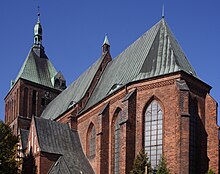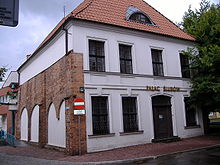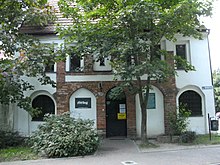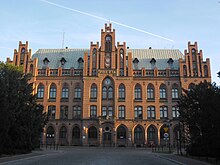Koszalin
| Koszalin Koszalin |
||
|---|---|---|
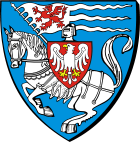
|
|
|
| Basic data | ||
| State : | Poland | |
| Voivodeship : | West Pomerania | |
| Powiat : | District-free city | |
| Area : | 83.20 km² | |
| Geographic location : | 54 ° 11 ' N , 16 ° 11' E | |
| Height : | 32 m npm | |
| Residents : | 107,981 (06/30/2015) | |
| Postal code : | 75-016 to 75-903 | |
| Telephone code : | (+48) 94 | |
| License plate : | ZK, ZKO | |
| Economy and Transport | ||
| Street : | DK 6 ( Szczecin - Gdansk ) | |
| DK 11 ( Kołobrzeg - Bytom ) | ||
| Ext. 167 (Koszalin– Ogartowo ) | ||
| Rail route : | PKP lines 202: Danzig – Stargard | |
| 402: Koszalin – Goleniów | ||
| Next international airport : | Szczecin-Goleniów | |
| Gmina | ||
| Gminatype: | Big city | |
| Residents: | 107,225 (Jun. 30, 2019) |
|
| Community number ( GUS ): | 3261011 | |
| Administration (as of 2015) | ||
| City President : | Piotr Jedliński | |
| Address: | Rynek Staromiejski 6-7 75-007 Koszalin |
|
| Website : | www.koszalin.pl | |
Koszalin [ koˈʂalʲin ], German Köslin , is a city in the Polish West Pomeranian Voivodeship with around 108,000 inhabitants . The second largest city in the voivodeship after Szczecin is a regiopole and has a high regional transport and economic importance. The independent city is the seat of the Powiat Koszaliński ( Kösliner Kreis ).
Geographical location
The city is located in Western Pomerania , about 151 kilometers northeast of the city of Szczecin and 193 kilometers west of the city of Gdansk . Twelve kilometers to the north is the Pomeranian compensation coast, upstream of which the Jamunder Lake with the two seaside resorts of Mielno (Groß Möllen) and Łazy ( Laase ) is located.
In the east and south, the city is surrounded by large forest areas, in which the 137 meter high Gollenberg (Góra Chełmska) rises.
history
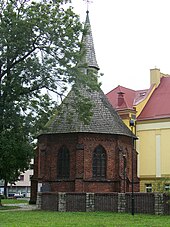
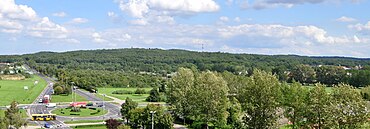
13th to 18th centuries
The place was first mentioned in 1214 as the village of Cossalitz in a deed of donation in which Duke Bogislaw II of Pomerania gave the place to the Belbuck monastery . In 1248 Cossalitz came to the diocese of Cammin . In the course of the German colonization in the east , the bishop of Cammin , Count Hermann von Gleichen , together with the Germans Marquardt and Hartmann, founded the city of Cussalin on May 23, 1266 , according to Lübischen city law . From around 1300 the area around Köslin was also settled by German farmers.
During the end of the Middle Ages, Köslin remained with the diocese of Cammin and was under the sovereignty of the sub-principality of Pomerania-Wolgast from 1356 to 1417/1422 . Köslin was on the important trade route from Stettin to Danzig and became a Hanseatic city . In 1447 Köslin had a successful military conflict with the larger Kolberg , which was more influential in the Hanseatic League and also belonged to Cammin . 1486 came Köslin with Cammin again under ducal-Pomeranian and thus Brandenburg suzerainty.
The city fire of 1504 initiated the decline of the city. In 1516 the city council issued an arbitrary decision prohibiting the use of the Slavic language for negotiations in the city market. In 1530 the Duchy of Pomerania became directly part of the empire . In 1534 the city became Protestant through the introduction of the Reformation in Pomerania, 11 years later the first Protestant bishop of Cammin, Bartholomäus Suave , took office. In 1556, Cammin became Pomeranian secondary school and Köslin became the prince- bishop 's residence after the installation of Duke Philip I's son Johann Friedrich as titular bishop. Johann Friedrich had a Renaissance castle built from 1569 to 1574, in which the dukes of Pomerania-Stettin resided as bishops of Cammin until 1622. Several plague epidemics and the Thirty Years War weakened the importance of Köslin further.
With the landing of Gustav Adolf at the Oder estuary in 1630, Pomerania with Köslin came under Swedish influence and in 1638 under Swedish administration.
With the Peace of Westphalia in 1648, Köslin came to the Elector of Brandenburg with Hinterpommern , whom the Emperor had enfeoffed with Pomerania during the war after the griffin dukes had died out.
The now Prussian city was again almost completely destroyed by fire in 1718, but it was rebuilt a few years with the help of King Friedrich Wilhelm I , who also set up the court in Köslin in 1720 for the Pomeranian hinterland . As a thank you, the Pomeranian estates dedicated a memorial in Köslin to him. In 1747 the Köslin Consistory was established, the judicial and administrative authority of the Evangelical Lutheran Church responsible for the Pomeranian hinterland.
19th to 21st century
In 1807 Köslin was under French occupation, but remained Prussian during the entire Napoleonic period.
The Prussian administrative reforms in 1816, the city Cöslin (then spelled) was county seat of district Koszalin and 1848 the seat of the provincial government of the administrative district of Koszalin in the Prussian province of Pomerania .
From 1858 to 1878 the railway from Stettin via Köslin and Stolp to Gdansk was built.
With the dissolution of the principality district on September 1, 1872, Cöslin became the seat of the district administrator for the new Cöslin district (December 13, 1872). The cadet school founded by Frederick the Great in 1776 was moved from Culm in West Prussia to Cöslin in 1890.
City arms from the 15th century to 1938 with a Johannis bowl .
City arms from 1938 with Wolfsangel , designed by Otto Hupp (used in modified form until 1959)
Around 1900 Köslin had a cadet house (until 1890 in Culm ), a grammar school, a Protestant school teacher seminar, an institution for the deaf and dumb, an agricultural winter school, a number of different factories and production facilities and was the seat of a regional court .
In 1911 the city opened a municipal electric tram, which was expanded into the Köslin city and beach tram in 1913 . As early as 1937/38 this railway was replaced by omnibuses. In 1924, the Traugott Onnasch vehicle factory in Köslin built small cars for a short time .
In the 1920s the name Cöslin was changed to Köslin. On April 1, 1923, the municipality of Köslin left the Köslin district and formed its own urban district until the reorganization after the Second World War .
Around 1930 the district of the city of Köslin had an area of 86.7 km², and in the city area there were a total of 1843 houses in 22 different places of residence.
- On the Kickelberg
- Augustenthal
- Hammerwald Chausseehaus
- Chausseehaus Kluss
- Forsthaus Buchwald
- Forsthaus Gollenberg
- Hammerwald Forestry House
- Forest house Kluss
- Friedrich-Wilhelm suburb
- Gollenthurm
- Hohetor suburb
- Koslin
- Mühlentor suburb
- Neuetor suburb
- Niedermühle
- Kluss paper mill
- Radeland
- City courtyard
- Wilhelmshof
- Wilhelmsthal
- Klitzke brickworks
- Treptow brickworks
In 1925 there were 28,812 inhabitants in the city of Köslin, including 706 Catholics and 170 Jews, who were spread over 7736 households.
The introduction of the Prussian Municipal Constitution Act of December 15, 1933 led to a uniform municipal constitution from January 1, 1934. The previous municipality of Köslin was given the name city . With the introduction of the German Municipal Code of January 30, 1935, a new uniform municipal constitution came into force in the German Reich on April 1, 1935.
Until 1945, Köslin was the capital of the Köslin administrative district in the Prussian province of Pomerania in the German Empire .
From the end of January 1945, towards the end of the Second World War , when the Red Army , which broke through near Warsaw, threatened to cut off East Prussia from the rest of Germany, refugees from East and West Prussia , around 65,000 people, moved westwards through Köslin towards Stettin. In mid-February, after reaching the Oder near Küstrin , the Soviet high command decided to occupy Pomerania as far as the Baltic Sea on the next train. After the breakthrough at Konitz to the north, Soviet troops were in Koslin on March 3rd.
On March 5, 1945, the Red Army occupied Köslin and burned down the inner city, with around 40% of the building material being destroyed. Then she subordinated Köslin to the administration of the People's Republic of Poland . This renamed the place in Koszalin . The inhabitants who did not flee from the Red Army or who returned in the spring of 1945 were expelled until 1947 and replaced by Poles .
For a short time, Köslin was the seat of the new Polish provincial administration for all of Western Pomerania . After Stettin was placed under Polish administration, the provincial administration was transferred there in 1946.
In 1950 the city became the capital of the Koszalin Voivodeship , which was abolished in 1998 as part of the administrative reform and incorporated into the new West Pomeranian Voivodeship .
Population development
| year | Residents | Remarks |
|---|---|---|
| 1740 | 2,535 | |
| 1782 | 2,933 | including 47 Jews |
| 1791 | 3,071 | including 47 Jews |
| 1794 | 3,286 | including 47 Jews |
| 1812 | 3,802 | including 13 Catholics and 28 Jews |
| 1816 | 4,636 | 17 Catholics and 60 Jews |
| 1831 | 6,541 | including 50 Catholics and 104 Jews |
| 1843 | 8,114 | 78 Catholics and 210 Jews |
| 1852 | 9,298 | including 61 Catholics and 242 Jews |
| 1861 | 11.303 | 113 Catholics and 278 Jews |
| 1890 | 17,810 | including 492 Catholics and 323 Jews |
| 1900 | 20,417 | with the garrison (a battalion of 54 infantry ), of which 597 were Catholics and 251 Jews |
| 1925 | 28,812 | including 706 Catholics and 170 Jews |
| 1933 | 30,389 | thereof 28,996 Evangelicals, 666 Catholics, two other Christians and 123 Jews |
| 1939 | 31,937 | thereof 29,112 Evangelicals, 961 Catholics, 704 other Christians and 25 Jews |

City structure
The independent city of Koszalin is divided into 17 districts ( osiedla , literally "settlements"):
Religions
The majority of the population of Köslin was Protestant from the Reformation until the end of the war in 1945. At the beginning of the 20th century Köslin had two Protestant churches, a Catholic church, an apostolic church and a synagogue .
The Polish migrants who immigrated after the end of the war in 1945 belonged to the Roman Catholic Polish Church.
The Poles living in Köslin today are organized in the Catholic Church in Poland . Since 1972 the city has been the bishopric of the Koszalin-Kołobrzeg diocese . On July 1, 1991 Pope John Paul II visited the city.
The Evangelicals are affiliated to the Evangelical Augsburg Church in Poland (Lutheran). Their church services take place in the Gertrudenkapelle , which was assigned to the parish of the diocese of Pomerania-Greater Poland (seat in Sopot ) of the Evangelical-Augsburg Church in Poland .
traffic
State roads DK 6 (former German Reichsstraße 2 , today also Europastraße 28 ) and DK 11 (former Reichsstraße 160 ) cross in the city. In addition, the provincial road 167 to the south and the province road 206 to the east begin in the city .
The city is the railway junction of the Polish State Railways (PKP). PKP lines 202 ( Gdańsk – Stargard (Stargard in Pomerania – Danzig) ) and 402 ( Goleniów – Koszalin (Gollnow – Köslin) ) run here. The nearest airport is in Szczecin-Goleniów .
politics
City President
A city president is at the head of the city administration . Since 2010 this has been Piotr Jedliński ( PO ). The 2018 elections brought the following results:
- Piotr Jedliński ( Koalicja Obywatelska ) 58.8% of the vote
- Andrzej Jakubowski ( Prawo i Sprawiedliwość ) 22.9% of the vote
- Wiktor Kamieniarz (Wiktor Kamieniarz Election Committee) 8.3% of the vote
- Mariusz Krajczyński (Election Committee “Better Koszalin”) 5.1% of the vote
- Stefan Romecki ( Kukiz'15 ) 3.9% of the vote
- Jerzy Zaroda ( Sojusz Lewicy Demokratycznej / Lewica Razem ) 2.6% of the vote
Jedliński was thus re-elected in the first ballot.
City council
The city council consists of 25 members and is directly elected. The 2018 city council election led to the following result:
- Koalicja Obywatelska (KO) 50.5% of the vote, 19 seats
- Prawo i Sprawiedliwość (PiS) 22.9% of the vote, 6 seats
- Election Committee "Better Koszalin" 8.5% of the vote, no seat
- Sojusz Lewicy Demokratycznej (SLD) / Lewica Razem (Razem) 7.2% of the vote, no seat
- Election committee Wiktor Kamieniarz 7.2% of the vote, no seat
- Kukiz'15 3.7% of the vote, no seat
Partnerships
Koszalin maintains relationships with twelve twin cities , which are:
| city | country | since |
|---|---|---|
|
Albano Laziale |
|
2008 |
|
Bourges |
|
1999 |
| Fuzhou |
|
2007 |
|
Gladsaxe |
|
1990 |
|
Ivano-Frankivsk |
|
2010 |
|
Kristianstad |
|
2004 |
|
Lida |
|
1993 |
|
Neubrandenburg |
|
1987 |
|
Neumunster |
|
1990 |
| Roermond |
|
|
|
Schwedt / Oder |
|
2004 |
|
Seinäjoki |
|
1988 |
|
Tempelhof-Schöneberg |
|
1995 |
|
Trakai |
|
2019 |
Sponsorship
The city of Minden took over the sponsorship for the city of Köslin in 1953 , in the sense of a sponsorship for the expelled Kösliner. The sponsorship continues to this day.
Culture and sights
Historic buildings
- The Catholic Cathedral of St. Mary was a Protestant parish church from 1534 to 1945. The three-aisled basilica from the brick Gothic was built between 1300 and 1333. The 57 meter high front tower is crowned by a pyramid roof with a baroque lantern. From the historical interior only the statues of the Gothic high altar remained, the four larger than life sculptures of the Madonna , John the Evangelist and the bishops Adalbert of Prague and Otto von Bamberg were placed in the choir. The remainder, attached to a steel frame, form a modern altar. The cathedral organ, an instrument by Schlag & Söhne from Schweidnitz from 1899 with 50 stops - which is built into a neo-Gothic prospect from 1842 - is a well-known concert organ in the region.
- The modern town hall of Köslin from 1960 to 1962 stands diagonally opposite the site of the old town hall on the market square, which was destroyed in 1945.
- The octagonal Gertraudenkapelle was built in 1383 in the Gothic style and serves as a place of worship for the Protestant community.
- Castle Church: The Gothic core building of the Castle Church, which was built around the turn of the 14th to the 15th century, was originally the monastery church of the Cistercian Sisters , who had their seat in Köslin between 1278 and the 50s of the 16th century. The church was redesigned several times in the following centuries, the conversion to the castle church took place from 1602 to 1609. In the 19th century, the church was finally redesigned in a neo-Gothic style. Today the church is used by an Orthodox community.
- The preserved remains of the medieval ring-shaped city wall from the 14th century, which was originally 1,600 m long and had three city gates and 46 watch towers.
- Some town houses also show their Gothic origins. For example the registry office or the hangman's house , a city-owned building in which the executioner's family lived (executions were carried out in public places in Köslin until the 19th century).
- The Müllerpalast, which was built between 1880 and 1897; it now houses a museum.
- The St. Josef Church, a neo-Gothic brick building that was built in 1868 for the Catholic community founded in 1857.
- The main post office building, a neo-Gothic brick building from 1884 and the seat of the post office until 1943.
- The neo-Gothic building of the polyclinic.
- The building of the Köslin State Archives, a neo-Gothic brick building. In the former Prussian state archive of the administrative district of Köslin today u. a. Pomeranian land register files and parish registers from the time before the Second World War kept.
- The brewery complex, a neo-Gothic brick building.
Natural monuments
- The witch tree , a sycamore maple on the Great Wall.
Personalities
Honorary citizen
- Karl Adolf Lorenz (1837–1923), German musician and composer, city music director in Stettin, made an honorary citizen in 1910
sons and daughters of the town
- Peter Becker (1491–1563), called Peter Artopoeus , German theologian and reformer, worked as a teacher in Köslin, Rügenwalde and Stettin
- Johannes Freder (1510–1562), German Evangelical Lutheran theologian and hymn poet
- Johann Martini (1558–1629), German schoolboy, rector of the Marienschule zu Danzig
- Andreas Hakenberger (1574–1627), German composer and conductor
- Anton von Schlieffen (1576–1650), German officer in imperial and Swedish service
- Gregor Lagus (1586–1652), German theologian
- Jakob Fabricius (1593–1654), German Evangelical Lutheran theologian, hymn poet and preacher
- Johannes Micraelius (1597–1658), German poet, philosopher and historian
- Samuel Plaster (1618–1678), German Protestant clergyman and theological writer
- Gabriel Schweder (1648–1735), German legal scholar
- Gottfried von Lehnsfeld (1664–1701), officer of the imperial army who was beheaded in Vienna
- Ewald Christian von Kleist (1715–1759), German poet and officer
- Christian David Lenz (1720–1798), German-Baltic clergyman, general superintendent in Livonia
- Christian Friedrich Helwing (1725–1800), German bookseller and mayor of Lemgo
- George Friedrich Felix von Bonin (1749-1818), Prussian district administrator
- August Christian Ludwig von Puttkamer (1750–1836) Prussian district administrator, war and domain councilor and chief accountant
- Ludwig August von Stutterheim (1751–1826), Prussian officer, most recently general of the infantry
- Heinrich Wilhelm von Schlieffen (1756–1842), Prussian officer, most recently lieutenant general and director of the disabled
- Martin Friedrich van Alten (1762–1843), Prussian construction clerk and university professor
- Karl Sigismund Wilhelm Gabriel von Liebenroth (1772–1857), Prussian officer, most recently lieutenant general
- Heinrich Samuel Gottlieb von Schaper (1782–1846), Prussian officer, most recently lieutenant general
- August Ernst Braun (1783–1859), German lawyer, politician and mayor of Köslin
- Wilhelm von der Horst (1786–1874), German officer, Prussian lieutenant general
- Friedrich Dagobert Deetz (1812–1871), German local politician, Lord Mayor of Frankfurt (Oder) and member of the Prussian mansion
- Ferdinand Karkutsch (1813–1891), German businessman, social activist and philanthropist
- Rudolf Meinecke (1817–1905), Undersecretary of State in the Prussian Ministry of Finance
- Johannes Neumann (1817–1886), landowner and member of the German Reichstag
- Rudolf Julius Emanuel Clausius (1822–1888), German physicist
- Hermann Grieben (1822–1890), German journalist and poet
- Bruno Bucher (1826–1899), German art writer and director of the Museum of Applied Arts in Vienna
- Hermann Haken (1828–1916), German lawyer and politician, Lord Mayor of Stettin
- Robert Hildebrand (1830–1896), German lawyer and member of the German Reichstag
- Friedrich Hermann Gustav Hildebrand (1835–1915), German botanist
- Karl Edel (1837–1921), German psychiatrist and founder of a private sanatorium in Berlin-Charlottenburg
- Karl Adolf Lorenz (1837–1923), German conductor, composer and music teacher
- Sophie Meyer (1847–1921), German painter from the Düsseldorf School
- Karl Conradt (1847–1922), German classical philologist and high school teacher
- Paul Thoemer (1851–1918), German architect and high-ranking Prussian building officer
- Joachim von Bonin (1857–1921), German politician (free conservative), Prussian member of the state parliament, district administrator in Aabenraa and Stormarn
- Traugott Bredow (1859–1928), German ministerial official
- Georg Mannkopff (1859–1933), German district administrator
- Lothar Heffter (1862–1962), German mathematician
- Gustav von Houwald (1862–1945), Government Vice President in Arnsberg
- Ulrich Hoffmann (1866–1936), Prussian major general
- Viktor Lampe (1869–1932), German church administration lawyer and president of the regional church office in Hanover
- Hans Richert (1869–1940), German school reformer
- Waldemar Moritz (1870–1948), German district administrator
- Emil Piegsa (1873–1952), German politician (SPD), member of the Gotha state parliament
- Bogislav von Selchow (1877–1943), German writer, naval officer and free corps leader
- Hans Grade (1879–1946), German aviation pioneer and automobile manufacturer
- Richard Fleischhut (1881–1951), German photographer, on-board photographer on transatlantic ships
- Karl Holzfäller (1884–1945), German politician (KPD), OdF
- Fritz von Brodowski (1886–1944), German officer, most recently lieutenant general
- Friedrich Wendel (1886–1960), German journalist and author
- Otto von Heydebreck (1887–1959), German journalist
- Alexander Andrae (1888–1979), artillery general in World War II
- Peter von Heydebreck (1889–1934), German free corps leader, politician (NSDAP) and SA leader
- Karl Minning (1889–1972), German politician (SPD), member of the Berlin House of Representatives
- Georg Wendt (1889–1948), German politician (SPD, SED), member of the Reichstag
- Walther John (1893–1971), German teacher and classical philologist
- Karl Passarge (1893–1967), German politician and administrative specialist, State Secretary in the ZEL of the British zone
- Fritz Latzke (1900–1958), German politician (USPD, KPD)
- Herbert Achterberg (1903–1983), German Protestant clergyman
- Heinz Pollay (1908–1979), German dressage rider, Olympic champion 1936
- Ekkehard Kyrath (1909–1962), German cameraman
- Karl-Heinz Schäfer (1911–1985), German pediatrician, rector of the University of Hamburg
- Rudolf Jürgen Bartsch (1921–2000), German writer, cabaret artist and speaker
- Martin Ruhnke (1921–2004), German musicologist and university professor
- Ilse Donath (* 1923), German table tennis champion 1952
- Botho Lucas (1923–2012), German accordionist, composer and choir director
- Hans-Joachim Preil (1923–1999), German playwright, director and comedian
- Leslie Baruch Brent (1925–2019), British immunologist and zoologist with German-Jewish parents, discovered the acquired immunological tolerance with Nobel Prize winner Peter Brian Medawar
- Klaus Gerth (1926–2012), German Germanist and university lecturer
- Hans Strutz (1926–2019), German museologist
- Karl-Otto Habermehl (1927–2005), German doctor and virologist
- Rudolf Rüthnick (* 1928), former German politician (SED), general forest master and deputy to the GDR Minister for Agriculture, Forestry and Food
- Manfred Sader (1928–2006), German psychologist and gestalt theorist
- Merten Drevs (* 1934), German lawyer in financial administration, State Secretary in Mecklenburg-Western Pomerania
- Heidi Lambert-Lang (* 1937), German lawyer, judge at the German Federal Court of Justice from 1981 to 2002
- Manfred Krüger (* 1938), German scholar, 1980–2010 professor of philosophy at the Ottersberg University of Applied Sciences
- Ingo Wolff (* 1938), German engineering scientist, emeritus professor for electrical engineering at the University of Duisburg-Essen
- Peter Hühn (* 1939), German Anglist, retired professor at the University of Hamburg
- Eva Peters (* 1939), German politician (CDU)
- Gudrun Reinhardt (* 1939), German politician (CDU)
- Waltraud Nowarra (1940-2007), German chess player
- Gisela Tuchtenhagen (* 1943), German camerawoman, film editor and film director
- Ludwig Braun (* 1943), German classical philologist and university professor
- Brigitte Broch (* 1943), German production designer
- Martin Onnasch (* 1944), German Evangelical Lutheran theologian
- Oda Wischmeyer (* 1944), German theology professor
- Dieter Birr ("machine") (* 1944), German rock musician (Puhdys)
- Angelika Zahrnt (* 1944), German politician, chairwoman of the Federation for the Environment and Nature Conservation in Germany (1998–2007)
- Marian Tałaj (* 1950), judoka
- Anka Grupińska (* 1956), non-fiction author and journalist
- Mirosław Okoński (* 1958), football player
- Andrzej Radomski (* 1961), wrestler
- Kuba Wojewódzki (* 1963), journalist and comedian
- Mirosław Trzeciak (* 1968), football player
- Sławomir Kurkiewicz (* 1975), jazz musician
- Kasia Cerekwicka (* 1980), singer
- Marzena Diakun (* 1981), conductor
- Jakub Różalski (* 1981), painter, illustrator and conceptual artist
- Łukasz Żal (* 1981), cameraman
- Krzysztof Dys (* 1982), jazz musician
- Sebastian Mila (* 1982), football player
- Schwesta Ewa (* 1984), rapper
- Joanna Majdan (* 1988), Polish chess player
- Natalia Kowalska (* 1989), Polish racing driver
- Klaudia Kulon (* 1992), Polish chess player
- Jakub Dyjas (* 1995), Polish table tennis player
Personalities who have worked in the city
- George Bogislav von Bonin (1701–1764), Prussian legal counsel, President of the court in Köslin from 1749 to 1764
- Ewald George von Pirch (1728–1797), Prussian legal counsel, president of the court in Köslin from 1769 to 1797
- August Gottlieb Ludwig Hering (1736–1770), German lawyer, court judge in Köslin and poet of evangelical sacred songs
- Paul Brandt (~ 1753–?), Prussian lawyer, Mayor of Köslin from 1776 to 1787
- Johann Ernst Benno (1777–1848), German writer, worked as a government official in Köslin
- August Ernst Braun (1783–1859), German lawyer, police director and mayor of Köslin
- Heinrich Beitzke (1798–1867), German military writer, lived in Köslin after leaving the army
- Friedrich Röder , (1808–1870), German philologist and grammar school teacher, director of the grammar school in Köslin from 1861 until his death
- Ludwig Josephson (1809–1877), German Evangelical Lutheran. Pastor, editor and writer, from 1858–1863 rector of the teachers' college in Köslin
- Rudolf Virchow (1821–1902), a doctor, attended the Köslin grammar school from May 1835 to Easter 1839
- Bernhard Presting (1831–1908), German religious educator, worked as a school councilor in Köslin
- Rudolf Hanncke (1844–1904), German historian, professor at the high school in Köslin
- Vally von Rüxleben (1864–1941), German writer, lived in Köslin from 1890 to 1902
- Hermann Kasten (1866–1946), German teacher, local researcher and poet, was the school principal in Köslin
- Walther Zubke (1882 – after 1934), German lawyer and politician (DNVP), worked as a lawyer in Köslin since 1911 and became head of the city council and member of the state parliament
- Richard Schallock (1896–1956), German politician (SPD, later SED), worked in Köslin during the Weimar Republic and was Mayor of Köslin in May and June 1945
- Paul Dahlke (1904–1984), German actor, grew up in Köslin
- Dietrich Bonhoeffer (1906–1945), German Lutheran theologian, continued the illegal vicar training for the Confessing Church from 1937 to 1939 in Köslin and Groß Schlönwitz
See also
literature
Digitized older titles
- Heinrich Berghaus : Land book of the Duchy of Pomerania and the Principality of Rügen . Part III, Volume 1, Anklam 1867, pp. 169-222.
- Gustav Kratz : The cities of the province of Pomerania, outline of their history, mostly according to documents . Bath, Berlin 1865, pp. 71-80 ( full text ).
- Johann Ernst Benno : The history of the city of Köslin from its foundation to the present day - edited according to documents and reliable sources . Köslin 1840, approx. 360 pages ( online ).
- Johann Ernst Fabri : Geography for all classes . Part I, Volume 4, Leipzig 1793, pp. 518-523 ( full text ).
- Ludwig Wilhelm Brüggemann (ed.): Detailed description of the current state of the Royal Prussian Duchy of Western and Western Pomerania . Part II, Volume 2, Stettin 1784, pp. 497-518 ( online )
- Christian Wilhelm Haken : An attempt at a diplomatic history of the Royal Prussian Immediate and former royal and episcopal residence town of Cößlin since it was established five hundred years ago. Lemgo 1765, continued 1767 ( online ).
Newer titles
- Roderich Schmidt : Köslin (Koszalin) . In: Helge bei der Wieden , Roderich Schmidt (Hrsg.): Handbook of the historical sites of Germany . Volume 12: Mecklenburg / Pomerania (= Kröner's pocket edition . Volume 315). Kröner, Stuttgart 1996, ISBN 3-520-31501-7 , pp. 216-219.
- Franz Schwenkler : 1266–1966 Köslin. The seven hundred year history of a Pomeranian city and its district. Pommerscher Buchversand, Hamburg 1966.
- Michael Rademacher: German Administrative History Province of Pomerania - City and District of Köslin (2006).
- Gunthard Stübs and Pomeranian Research Association: The urban district of Köslin in the former province of Pomerania (2011)
Web links
- Website of the city of Koszalin (Polish / German / English)
- The urban district of Köslin in the former province of Pomerania (Gunthard Stübs and Pommersche Forschungsgemeinschaft, 2011).
- Heimatkreis Köslin (German)
- Evangelical-Augsburg congregation in Köslin (Polish / German)
- Memories of Johannes Dittrich of his youth in Cöslin between 1864 and 1870 in 18 chapters
Individual evidence
- ↑ Główny Urząd Statystyczny, online query as Excel file: Portret miejscowości statystycznych w gminie Police (powiat policki, województwo zachodniopomorskie) w 2013 r. Update of the 2011 census (Polish, accessed on January 21, 2016)
- ↑ population. Size and Structure by Territorial Division. As of June 30, 2019. Główny Urząd Statystyczny (GUS) (PDF files; 0.99 MiB), accessed December 24, 2019 .
- ^ City website, Prezydent Miasta Koszalina , accessed February 24, 2015
- ^ Klaus Conrad (arrangement): Pommersches Urkundenbuch . Volume 1, 2nd edition, Böhlau Verlag, Cologne / Vienna 1970, No. 163.
- ↑ Klaus Herbers, Nikolas Jaspert (ed.), Border areas and border crossings in comparison: The East and the West of medieval Latin Europe , Berlin 2007, p. 86, ISBN 3-05-004155-2
- ↑ Köslin / Koszalin. Common symbols. Information on the coat of arms in the online lexicon on the culture and history of Germans in Eastern Europe at the University of Oldenburg
- ↑ Sebastian Zbigniew Kempisty: Herby Koszalina (The coat of arms of Köslin)
- ^ Home district of Köslin in Pomerania: Köslin - Culture and Churches
- ↑ Zdzisław Pacholski: Herby Koszalina (The coat of arms of Köslin)
- ↑ a b c Meyer's Large Conversation Lexicon . 6th edition, Volume 7, Leipzig / Vienna 197, p. 526.
- ↑ a b c Gunthard Stübs and Pomeranian Research Association: The city of Köslin in the former Köslin district in Pomerania (2011)
- ↑ Peter Gosztony (Ed.): The fight for Berlin 1945 in eyewitness reports. First edition: Karl Rauch Verlag, Düsseldorf 1970, quoted here from: Deutscher Taschenbuch Verlag, Munich 1985, p. 89.
- ^ A b c d e f g h i Gustav Kratz : The cities of the province of Pomerania, outline of their history, mostly according to documents . Berlin 1965, p.77 .
- ↑ Christian Friedrich Wutstrack (Ed.): Short historical, geographical, statistical description of the royal Prussian duchy of Western and Western Pomerania . Stettin 1793, overview table on p. 736.
- ^ A b c Michael Rademacher: German administrative history from the unification of the empire in 1871 to the reunification in 1990. koeslin.html. (Online material for the dissertation, Osnabrück 2006).
- ^ Result on the website of the election commission, called on August 12, 2020.
- ↑ Result on the website of the election commission, accessed on August 12, 2020.
- ↑ Miasta partnerskie ǀ Serwis Urzedu Miejskiego w Koszalinie. Retrieved December 6, 2016 .
- ↑ koeslin.org
- ↑ Sponsorship on the website of the city of Minden.
- ↑ See koeslin.org ; down. on August 25, 2008
- ↑ See katedra.koszalin.pl ( Memento of the original from May 6, 2009 in the Internet Archive ) Info: The archive link was automatically inserted and not yet checked. Please check the original and archive link according to the instructions and then remove this notice. ; down. on August 25, 2008.
- ↑ Cf. organy.art.pl ( Memento of the original from June 24, 2006 in the Internet Archive ) Info: The archive link was automatically inserted and not yet checked. Please check the original and archive link according to the instructions and then remove this notice. ; down. on August 25, 2008.
- ^ The Pomeranian Newspaper . No. 26/2014, p. 7.
- ^ Heinz Otremba: Rudolf Virchow. Founder of cellular pathology. A documentation. Echter-Verlag, Würzburg 1991, p. 7.




